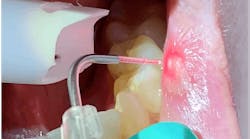CHICAGO, Dec. 5, 2012 — In an effort to decrease radiation exposure to patients, the American Dental Association’s Council on Scientific Affairs collaborated with the U.S. Food and Drug Administration to update the ADA’s recommendations for dental X-ray examinations. The recommendations were released recently.
The ADA’s “Dental Radiograph Examinations: Recommendations for Patient Selection and Limiting Radiation Exposure” are intended to be used in conjunction with dentists’ professional judgment to determine whether and when dental X-rays are needed. Dental X-rays help dentists evaluate and diagnose oral diseases and conditions, but the ADA recommends that dentists weigh the benefits of taking dental X-rays against the possible risk of exposing patients to the radiation from X-rays, the effects of which can accumulate from multiple sources over time.
RELATED INFORMATION ...
To take the dental radiograph or not: that is the question
Patient dose reduction in dental imaging
Everything you need to know about CBCT in dentistry
American Dental Association shares its position on dental X-rays
Planmeca USA seeks ways to reduce dental radiation exposure
Sending dental X-rays: Why email should not be your option
“As doctors of oral health, dentists are in the best position to make decisions on whether to prescribe dental X-rays after an oral examination and with consideration of the patient’s health history. Prescribing dental X-rays should be an individualized process,” said ADA President Robert A. Faiella, DMD, MMSc. Since 1989, the ADA has recommended the ALARA principle in relation to dental X-rays — that radiation exposure to patients is “as low as reasonably achievable.”
Changes to the recommendations include:
• Updates to patient shielding recommendations
• Addition of a new section on limiting radiation exposure during radiographic examinations
• Including new topics such as receptor selection, handheld X-ray units, technique charts, and radiation risk communication
The ADA’s Council on Scientific Affairs (CSA) consulted with dental radiology experts about a year ago to update the recommendations. The CSA then sent the recommendations for peer review and for review by nondental organizations such as the Conference of Radiation Control Program Directors and the American Association of Physicists in Medicine. The recommendations are intended to serve as a resource for dentists and are not intended to be standards of care, requirements, or regulations.
The not-for-profit American Dental Association is the nation's largest dental association, representing 157,000 dentist members. The premier source of oral health information, the ADA has advocated for the public's health and promoted the art and science of dentistry since 1859. The ADA's state-of-the-art research facilities develop and test dental products and materials that have advanced the practice of dentistry and made the patient experience more positive. The ADA Seal of Acceptance long has been a valuable and respected guide to consumer dental care products. For more information, visit the ADA website. For more information on oral health, including prevention, care, and treatment of dental disease, visit the ADA’s consumer website.





